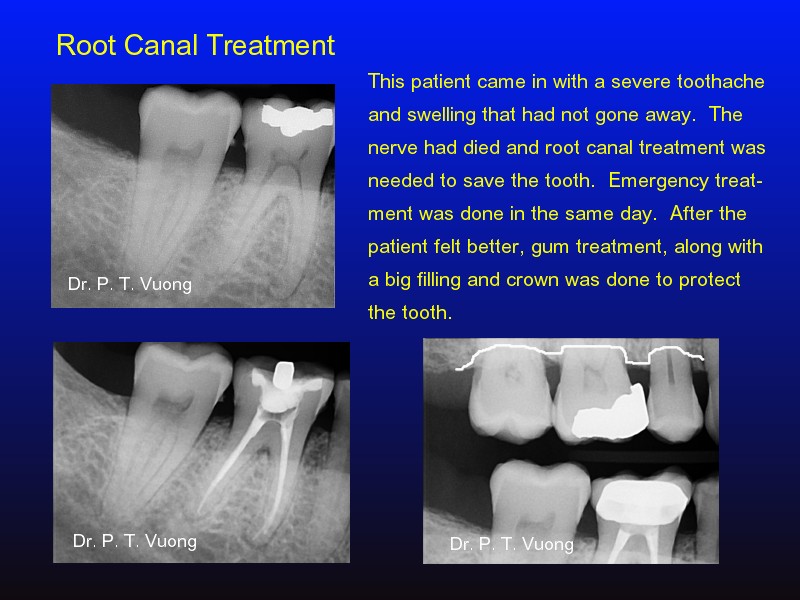What is gum disease that you hear often in the news? You may have heard of the term gingivitis, but what is periodontitis? Are you at risk for it? What is the consequence of no treatment?
You can ask yourself some of these questions: When was the last time you were at a dentist? Do you notice that your gum bleeds when you brush or floss? Do you have problem with the floss shredding? Do you have unpleasant breath? Food trapped easily between your teeth? How about any tooth that is loose? Sensitive when you chew or experience cold temperature?
You can ask yourself some of these questions: When was the last time you were at a dentist? Do you notice that your gum bleeds when you brush or floss? Do you have problem with the floss shredding? Do you have unpleasant breath? Food trapped easily between your teeth? How about any tooth that is loose? Sensitive when you chew or experience cold temperature?
Those are some of the signs of gum disease, better known as periodontal disease. Here's a summary:
Red, swollen, tender gums
Gums that bleed easily
Gums that have pulled away from the teeth
Persistent bad breath or bad taste
Pus between your teeth and gums
Permanent teeth that are loose or separating
Sensitive when chewing hard chewy food
Any change in the way your teeth fit together when you bite
Any change in the fit of your partial dentures
You may have periodontal disease and have no warning signs. Gum disease may not cause any pain either. That is why it is important to visit your dentist regularly for comprehensive checkups and periodontal examination. Gum treatment options depend on the severity and its progression.
Periodontal disease is classified into two major stages: gingivitis and periodontitis.
Gingivitis is the early stage of gum disease, where there is an increased inflammation of the gum. The gum bleeds easily, can be swollen, and red due to increased vascularity of the tissues. When you touch the tissues, the blood vessels break and bleed. The inflammation is caused by build up of plaque, or a layer of bacteria. Over time, the plaque buildup hardens by a process known as calculus formation. Calculus creates a haven and matrix for faster bacteria colonization. Your body tries to protect against the bacteria by making more blood vessels and to remove the toxins produced by the bacteria. Gingivitis can be easily treated by professional cleaning, good oral hygiene with the use of anti-baterial mouth rinse, regular brushing and flossing to remove plaque buildup. In addition, removal of plaque buildup would also prevent cavities, especially those in between the contacts of teeth.
 |
A periodontal abscess that caused
a toothache, resulted from bone loss,
gum infection, swelling, bad taste.
|
Periodontitis, also known as pyorrhea, is the later stage of gum disease, combined with attachment breakdown and bone loss. The tooth root will separate from the bone. Left untreated, it can become too severe that the bone lost can not be replaced or rebuilt. Most people with periodontitis may not have any symptoms. On occasion, someone may have a periodontal abscess and dull toothache from advanced periodontal disease. Dr. Vuong recommends a full set of x-rays to show the bone level, and sometimes the amount of calculus buildup, or harden minerals could be seen on the radiographs. Visual exam may miss the early stages of periodontal disease. We determine the amount of periodontal pocket depths or amount of gum detachment from your teeth. We will provide the appropriate treatment recommendations, depending on the severity of the disease. The earlier gum disease is diagnosed and treated, the better the prognosis in saving your teeth.
 |
Early periodontitis shows swollen, puffy, sensitive, easily bleeding red gums, and calculus (white hardened) buildup.
|
This young patient had early gum disease. Notice the red puffy gum and black buildups along the gum line. Besides sensitivity to cold, the gum is very tender and sensitive, and bleeds readily when brushing or touching even gently. This patient has sought treatment at the appropriate time, and he will have a beautiful healthy smile in a short time. Had he waited too long, gum disease can become very advanced, as illustrated in the case below.
For advanced gum disease, most often patients end up with all teeth removed and immediate dentures made, as illustrated in the case above.
Some factors increase the risk of developing periodontal disease (not in order of significance):
Tobacco smoking or chewing
Systemic wide diseases such as diabetes
Some medications such as steroids, anti-epilepsy drugs, cancer therapy drugs, calcium channel blockers, and oral contraceptives
Bridges and partials that no longer fit properly
Crooked teeth
Fillings or dental restorations that have become defective
Pregnancy and puberty
Genetic predisposition--research shows 30% of population is genetically susceptible
Stress, clenching, and grinding of teeth
Poor oral hygiene and lack of regular professional care
In this video, Whoopi Goldberg talks about her personal experience with periodontal disease, particularly about a severe periodontal abscess!
 |
Advanced periodontitis that has been treated,
well maintained, and stabilized.
|
This is a case that Dr. Vuong has treated for advanced periodontitis. The patient has been very diligent in maintaining plaque control, and keeping gums and teeth clean. Not all advanced periodontal disease will lead to dentures! Though bone has been lost, the gum tissue is very healthy and the teeth are strong!
Good oral hygiene at home is important to keep periodontal disease from becoming more serious or recurring. You may have had gum treatment in the past, but without regular maintenance, you may still have active gum disease. You don't have to lose teeth to periodontal disease! Brush regularly, clean between your teeth by flossing, eat a balanced diet, and schedule your regular dental visits for a lifetime of healthy smiles!
Periodontal disease is serious, but don't let fear or embarrassment keep you away from seeking care.












